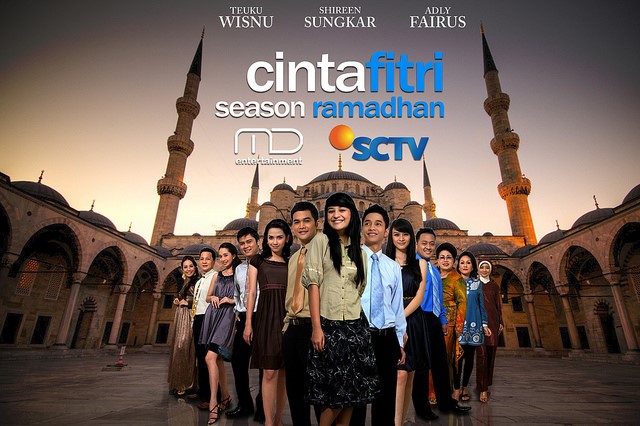The religious influence of prime-time television in Indonesia
Inaya Rakhmani
Promotional poster for Cinta Fitri Season Ramadhan.
A medium that penetrates over 90 per cent of the total population, broadcast television remains a strong influence over how the majority middle class in urban areas spend their money and spare time. Melodrama, widely known in Indonesia as sinetron, has a privileged position in prime time television – where the highest number of viewers tune in. In the 1990s, sinetron predominantly used to show the dream of luxury living and the lifestyles of the upper-middle class, influenced by Bollywood television drama. However, in the past 15 years, Indonesians across the country have followed the popular rise of Islamic sinetron, locally known as sinetron religi, which offer upper to lower class Muslims religious guidance in dealing with life’s trials and tribulations.
The days of early television commercialisation allowed only ‘safe’ portrayals of religion, in line with New Order’s SARA safeguards (avoiding the sensitive topics of Ethnicity, Religion, Race and Intergroup relations). Producers then introduced portrayals of Islamic imagery, such as prayer scenes and rituals, into the sinetron scripts in the late 1990s, just as the influence of political Islam was rising in wider urban society. The term sinetron religi became popular in the early 2000s with the unexpected success of the low-brow sinetron Rahasia Ilahi (God’s Secret), which showed Muslims who had deviated from the righteous path being punished by inexplicable supernatural events. Its low production cost and high-ratings then inspired a rash of sinetron religi eager to replicate its success.
Such a phenomenon did not go unnoticed and there were mixed responses towards the emerging trend. On the one hand, intellectuals, most notably film critic Eric Sasono, criticised television stations for cashing in on increasing Islamic piety, and that sinetron religi trivialised Islamic values and misled Muslim audiences. On the other hand, when the film Ayat-ayat Cinta (Verses of Love; Bramantyo) gained popularity in 2008, also generating a raft of similar melodramas on television, Din Syamsuddin, then head of one of the largest Muslim organisations, Muhammadiyah, praised it for providing an alternative portrayal of a peaceful Islam amidst the prevailing association of Islam and violence.
There is one sinetron religi that stands out among these replications. Citra Sinema, a production house owned by a former chairman of the National Film Council, Deddy Mizwar, explicitly uses sinetron as a means of da’wah - or Islamic mission. Its writers consult with fiqh (Islamic jurisprudence) experts to verify adherence to scholarly Qur'anic interpretation. Significantly, eight years on, its sinetron religi still hit highest ratings during the month of Ramadan, and since 2010 has also triggered the trend of comedic sinetron religi that are shown throughout the year.
Sinetron religi broadcast on broadcast television must achieve high ratings and be able to attract advertising. Accordingly, producers need to be sensitive to the values their Muslim viewers wish to preserve. Producers have learned to take their cue from the protests received by the Indonesian Broadcasting Commission (KPI). In the past ten years, for instance, KPI has limited and banned certain portrayals of mysticism, horror and the supernatural in order to protect young viewers, effectively reducing the production of supernatural dramas. In 2008, the Islamic melodrama Hareem was censured for its portrayal of polygamy as a means to justify men’s sexual pleasures. In 2013, KPI received protests regarding the depiction of Islamic teachers in the religious comedy Islam KTP (Superficial Muslims) who ideally should be portrayed as knowledgeable and not erroneous.
These developments reveal that there is a link between the commodification of Islam with the utilisation of television as a tool for da’wah. Both have intermingled and blended in a combined effort between producers, audiences and the regulatory body that has perpetuated the trend. Producers continue to create commercially successful programmes, viewers take pleasure from shows that do not contradict their values, and KPI guarantees that television content corresponds with their normative perception of the public’s needs.
 Promotional poster for Tukang Bubur Naik Haji (Porridge Seller Goes on the Haj)What has been established in the past decade raises an important question: What kind of ‘Islam’ is being shown on Indonesian television today?
Promotional poster for Tukang Bubur Naik Haji (Porridge Seller Goes on the Haj)What has been established in the past decade raises an important question: What kind of ‘Islam’ is being shown on Indonesian television today?
In an attempt to gain as broad a Muslim audience as possible, and at the same time avoid protests from heterogeneous Muslim Indonesians, sinetron religi do not have a single dominant narrative. It furthermore blurs the division between ‘traditionalist’, ‘modernist’, ‘conservative’ and ‘liberal’ interpretations of Islamic doctrines as reflected in how Indonesian Muslims organise themselves politically.
These portrayals take on a life of their own, for they are supported by advertisers rather than coming from a particular Muslim organisation. Consequently, what we have been viewing on Indonesian television is not a reflection of the debates or the development of Islamic thinking among mainstream Indonesian society, but a construct that has emerged out of a symbiosis between commercialisation and da’wah.
Inaya Rakhmani (inaya.rakhmani@gmail.com, inaya.r@ui.ac.id) is the head of the Communication Research Centre, Faculty of Social and Political Sciences, Universitas Indonesia and an associate at the Asia Research Centre, Murdoch University, Australia. Part of this article is published in Jurnal Sosiologi Masyarakat, Universitas Indonesia.
Other related articles from the II archive:
'Sinetron and soap boxes'. Elisabeth Kramer, 108: Apr-June 2012
'Stars and stereotypes'. Asriana Kebon, Edition 103: Jan-Mar 2011
Inside Indonesia 118: Oct-Dec 2014{jcomments on}



